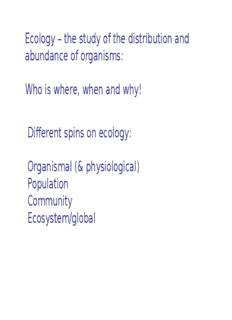
Ecology – the study of the distribution and abundance of PDF
Preview Ecology – the study of the distribution and abundance of
Ecology – the study of the distribution and abundance of organisms: Who is where, when and why! Different spins on ecology: Organismal (& physiological) Population Community Ecosystem/global Organismal ecology How do individuals interact with each other and their physical environment? The “interact… physical environment” hook is the physiological ecology part. Con-specific behaviors, like aggression & territoriality affect where you find organism s! Population biology How and why does population size change over time? Each female salmon produces thousands of eggs. Only a few will survive to The science of population growth adulthood. On is based on intrinsic biological average, only two factors, resource availability, will return to the immigration and emigration, and stream of their mortality. birth to breed. Community ecology How do species interact, and what are the consequences? In this case the bear is interacting with the fish by eating it. The consequence for this fish is…the big stream in the sky! Ecosystem ecology How do energy and nutrients cycle through the environment? (What happens to the dead fish?) Many communities, plus abiotic factors, control energy flow through the biosphere. Figure 50-1d Biological Science 2/e ©2005 Pearson Prentice Hall, Inc. Abiotic factors (but not just) control where you find organisms, and what types of organisms (physical and physiological features). For example, ambient temperature! The basic needs of organisms: 1. Water In general, life 2. Nutrients is an interface 3. Energy phenomenon! Energy enters biosphere by organisms that trap it: Photoautotrophs (green plants) or chemoautotrophs. Energy available to photoautotrophs is not evenly distributed, either geographically or seasonally. North pole Small amount of sunlight per unit area 60°N Low angle of incoming sunlight Moderate angle of incoming sunlight 30°N Sunlight directly overhead Large amount of sunlight per unit area Equator Uneven distribution of sunlight uneven heating BTW, life exists at the low end of the temperature scale Sunlight – limits photosynthesis Temperature depends on sunlight – speed of chemical reactions in ectothermic organisms Wind depends on temperature So… differential sunlight differential heating differential air movement Of the three essentials: Water Sunlight is the most limiting Nutrients in the aquatic environment Energy and water in the terrestrial environment. Differential sunlight Differential heating Air movement Air takes water along … so differential sunlight controls water distribution in the terrestrial environment.
Description: